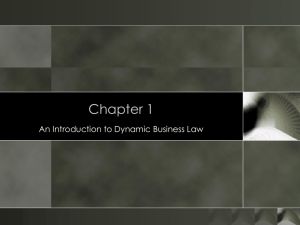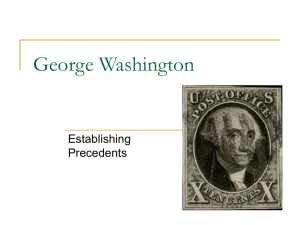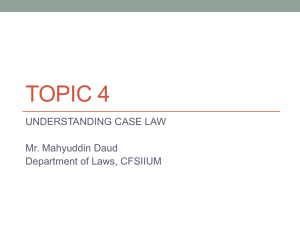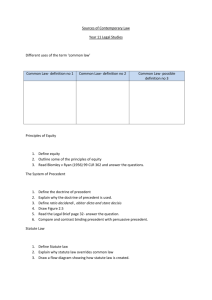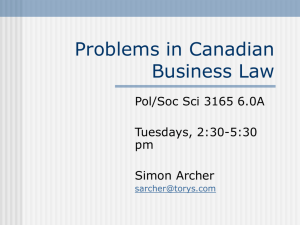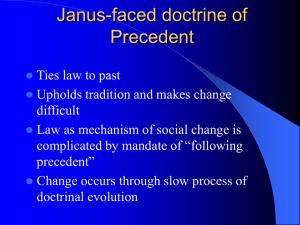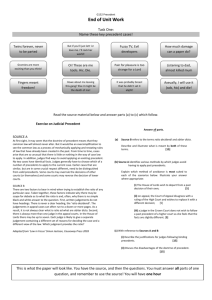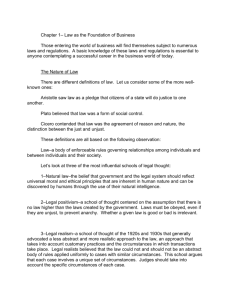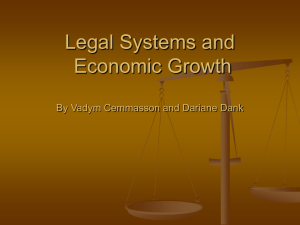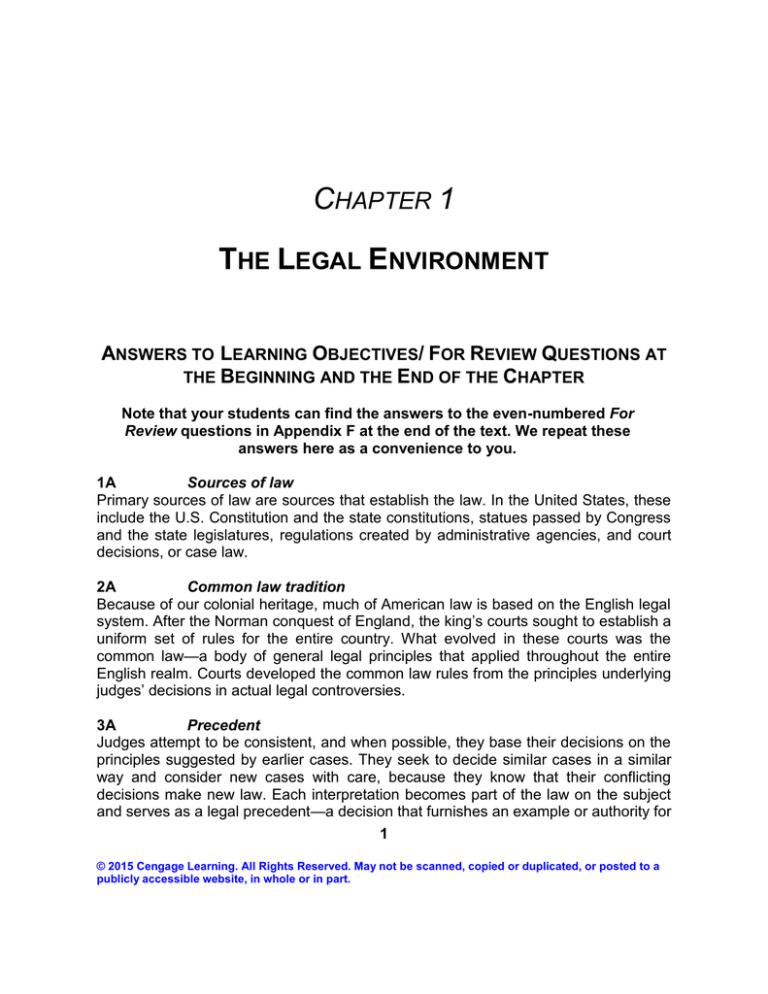
CHAPTER 1
THE LEGAL ENVIRONMENT
ANSWERS TO LEARNING OBJECTIVES/ FOR REVIEW QUESTIONS AT
THE BEGINNING AND THE END OF THE CHAPTER
Note that your students can find the answers to the even-numbered For
Review questions in Appendix F at the end of the text. We repeat these
answers here as a convenience to you.
1A
Sources of law
Primary sources of law are sources that establish the law. In the United States, these
include the U.S. Constitution and the state constitutions, statues passed by Congress
and the state legislatures, regulations created by administrative agencies, and court
decisions, or case law.
2A
Common law tradition
Because of our colonial heritage, much of American law is based on the English legal
system. After the Norman conquest of England, the king’s courts sought to establish a
uniform set of rules for the entire country. What evolved in these courts was the
common law—a body of general legal principles that applied throughout the entire
English realm. Courts developed the common law rules from the principles underlying
judges’ decisions in actual legal controversies.
3A
Precedent
Judges attempt to be consistent, and when possible, they base their decisions on the
principles suggested by earlier cases. They seek to decide similar cases in a similar
way and consider new cases with care, because they know that their conflicting
decisions make new law. Each interpretation becomes part of the law on the subject
and serves as a legal precedent—a decision that furnishes an example or authority for
1
© 2015 Cengage Learning. All Rights Reserved. May not be scanned, copied or duplicated, or posted to a
publicly accessible website, in whole or in part.
2
UNIT ONE: THE LEGAL ENVIRONMENT OF BUSINESS
deciding subsequent cases involving similar legal principles or facts. A court will
depart from the rule of a precedent when it decides that the rule should no longer be
followed. If a court decides that a precedent is simply incorrect or that technological or
social changes have rendered the precedent inapplicable, the court might rule
contrary to the precedent.
4A
Remedies
An award of compensation in either money or property, including land, is a remedy at
law. Remedies in equity include a decree for specific performance (an order to
perform what was promised), an injunction (an order directing a party to do or refrain
from doing a particular act), and rescission (cancellation) of a contract (and a return of
the parties to the positions that they held before the contract’s formation). As a rule,
courts will grant an equitable remedy only when the remedy at law (money damages)
is inadequate. Remedies in equity on the whole are more flexible than remedies at
law.
5A
Civil law and criminal law
Civil law spells out the rights and duties that exist between persons and between
persons and their governments, and the relief available when a person’s rights are
violated. In a civil case, a private party may sue another private party (the government
can also sue a party for a civil law violation) to make that other party comply with a
duty or pay for damage caused by a failure to comply with a duty. Criminal law has to
do with wrongs committed against society for which society demands redress. Local,
state, or federal statutes proscribe criminal acts. Public officials, such as district
attorneys, not victims or other private parties, prosecute criminal defendants on behalf
of the state. In a civil case, the object is to obtain remedies (such as damages) to
compensate an injured party. In a criminal case, the object is to punish a wrongdoer to
deter others from similar actions. Penalties for violations of criminal statutes include
fines and imprisonment, and in some cases, death.
ANSWERS TO CRITICAL THINKING
QUESTIONS IN THE FEATURES
ADAPTING THE LAW TO THE ONLINE ENVIRONMENT—CRITICAL THINKING (PAGE 11)
Does this argument justify the different treatment for unpublished opinions in
the state and federal courts? Explain. Yes, because categorizing some decisions,
unpublished or otherwise, as not establishing precedent is arguably unconstitutional.
No, because such decisions are often less significant or may set “bad” precedents
and have not traditionally been regarded as establishing precedent.
© 2015 Cengage Learning. All Rights Reserved. May not be scanned, copied or duplicated, or posted to a
publicly accessible website, in whole or in part.
CHAPTER 1: THE LEGAL ENVIRONMENT
3
BEYOND OUR BORDERS— CRITICAL THINKING (PAGE 16)
Does the civil law system offer any advantages over the common law system, or
vice versa? The positive and negative aspects of the characteristics of each legal
system make up its advantages and disadvantages. For example, on the one hand, a
civil law system relies on a code of laws without regard to precedent. When a statute
is clear, this can make the application of law more standard. When a statute is
ambiguously phrased, it can be subject to different interpretations, however, which
can lead to unpredictable applications. On the other hand, in a common law system,
reliance on precedent is required, which can render the application of an unclear
statute more predictable, at least in a give jurisdiction. But a statute that is not clearly
phrased may not be uniformly interpreted and applied across jurisdictions.
ANSWERS TO QUESTIONS IN THE REVIEWING FEATURE
AT THE END OF THE CHAPTER
1A.
Parties
In this situation, the automobile manufacturers are the plaintiffs, and the state of
California is the defendant.
2A.
Remedy
The plaintiffs are seeking an injunction, which is an equitable remedy, to prevent the
state of California from enforcing its statute restricting carbon dioxide emissions.
3A.
Source of law
This case involves a law passed by the California legislature and a federal statute,
thus the primary source of law is statutory law.
4A.
Finding the law
Federal statutes are found in the United States Code, and California statutes are
published in the California Code. You would look in both of these sources to find the
relevant state and federal statutes.
ANSWER TO DEBATE THIS QUESTION IN THE REVIEWING FEATURE
AT THE END OF THE CHAPTER
Under the doctrine of stare decisis, courts are obligated to follow the
precedents established in their jurisdictions unless there is a compelling
© 2015 Cengage Learning. All Rights Reserved. May not be scanned, copied or duplicated, or posted to a
publicly accessible website, in whole or in part.
4
UNIT ONE: THE LEGAL ENVIRONMENT OF BUSINESS
reason not to. Should U.S. courts continue to adhere to this common law
principle, given that our government now regulates so many areas by statute?
Both England and the U.S. legal systems were constructed on the common law
system. The doctrine of stare decisis has always been a major part of this system—
courts should follow precedents when they are clearly established, excepted under
compelling reasons. Even though more common law is being turned into statutory
law, the doctrine of stare decisis is still valid. After all, even statutes have to be
interpreted by courts. What better basis for judges to render their decisions than by
basing them on precedents related to the subject at hand?
In contrast, some students may argue that the doctrine of stare decisis is
passé. There is certainly less common law governing, say, environmental law than
there was 100 years ago. Given that federal and state governments increasingly are
regulating more aspects of commercial transactions between merchants and
consumers, perhaps the courts should simply stick to statutory language when
disputes arise.
ANSWERS TO ISSUE SPOTTERS IN THE EXAMPREP FEATURE AT THE
END OF THE CHAPTER
1A
The First Amendment provides protection for the free exercise of religion.
A state legislature enacts a law that outlaws all religions that do not derive from
the Judeo-Christian tradition. Is this law valid within that state? Why or why
not? No. The U.S. Constitution is the supreme law of the land, and applies to all
jurisdictions. A law in violation of the Constitution (in this question, the First
Amendment to the Constitution) will be declared unconstitutional.
2A. Under what circumstance might a judge rely on case law to determine the
intent and purpose of a statute? Case law includes courts’ interpretations of statutes, as well as constitutional provisions and administrative rules. Statutes often
codify common law rules. For these reasons, a judge might rely on the common law as
a guide to the intent and purpose of a statute.
© 2015 Cengage Learning. All Rights Reserved. May not be scanned, copied or duplicated, or posted to a
publicly accessible website, in whole or in part.
CHAPTER 1: THE LEGAL ENVIRONMENT
5
ANSWERS TO QUESTIONS AND CASE PROBLEMS
AT THE END OF THE CHAPTER
BUSINESS SCENARIOS AND CASE PROBLEMS
1–1A
Binding v. persuasive authority
(BLTC page 10)
A decision of a court is binding on all inferior courts. Because no state’s court is
inferior to any other state’s court, no state’s court is obligated to follow the decision of
another state’s court on an issue. The decision may be persuasive, however,
depending on the nature of the case and the particular judge hearing it. A decision of
the United States Supreme Court on an issue is binding, like the decision of any court,
on all inferior courts. The United States Supreme Court is the nation’s highest court,
however, and thus, its decisions are binding on all courts, including state courts.
1–2A
Remedies
(BLTC pages 11 & 28)
1
In a suit by Arthur Rabe against Xavier Sanchez, Rabe is the plaintiff
and Sanchez is the defendant.
2
Specific performance is the remedy that includes an order to a party to
perform a contract as promised.
3
Rescission is a remedy that includes an order to cancel a contract.
4
In both cases, these remedies are remedies in equity.
5
If Sanchez appeals the decision, Sanchez would be the appellant (or
petitioner) and Rabe would be the appellee (or respondent).
1–3A
QUESTION WITH SAMPLE ANSWER—Sources of law
The U.S. Constitution is the supreme law of the land. A law in violation of the
Constitution, no matter what its source, will be declared unconstitutional and will not
be enforced. In this problem, the court determined that a Massachusetts state statute
was in conflict with the U.S. Constitution. The Constitution takes priority, so the statute
will not be enforced.
In the actual case on which this problem is based, the trial court held that the
statute violated the Constitution, and the U.S. Court of Appeals for the First Circuit
affirmed this holding. Under the statute’s definitions of large and small wineries, most
of the small wineries were in state, and all of the large wineries were out-of-state. The
court found that the purpose of the statute was to “ensure that Massachusetts’
wineries obtained an advantage over their out-of-state counterparts.”
© 2015 Cengage Learning. All Rights Reserved. May not be scanned, copied or duplicated, or posted to a
publicly accessible website, in whole or in part.
6
UNIT ONE: THE LEGAL ENVIRONMENT OF BUSINESS
1–4A
Philosophy of law
(BLTC page 13)
Crimes against humanity constituted, at the time of the Nuremberg trials, a new international crime, consisting of “murder, extermination, enslavement, deportation, and
other inhumane acts committed against any civilian population, before or during the
war, or persecutions on political, racial or religious ground.” In response to the
defendants’ assertion that they had only been following orders, the Nuremberg judges
explained in part that these were familiar crimes within domestic jurisdictions and that
thus the accused must have known, when they committed their acts, that they would
be considered criminal. In terms of a philosophy of law, it might be said that these
criminals violated “natural law.” The oldest and one of the most significant schools of
jurisprudence is the natural law school. Those who adhere to the natural law school
of thought believe that government and the legal system should reflect universal moral
and ethical principles that are inherent in human nature. Because natural law is universal, it takes on a higher order than positive, or conventional, law. The natural law
tradition presupposes that the legitimacy of conventional, or positive, law derives from
natural law. Whenever it conflicts with natural law, conventional law loses its
legitimacy. For example, a precept of natural law may be that murder is wrong, which
is a value reflected by specific laws prohibiting murder. If a specific, written law
requires murder, it conflicts with the natural law precept, in which case individuals
should disobey the written law and obey the natural law.
1–5A
Reading citations
(BLTC page 22)
The court’s opinion in this case—McKee v. Laurion, 825 N.W.2d 725 (Minn. 2013)—
can be found in volume 825 of West’s Northwestern Reporter, Second Series, on
page 725. The Minnesota Supreme Court issued this opinion in 2013.
1–6A
CASE PROBLEM WITH SAMPLE ANSWER—Law around the world
The common law system spread throughout medieval England after the Norman
Conquest in 1066. Courts developed the common law rules from the principles behind
the decisions in actual legal controversies. Judges attempted to be consistent. When
possible, they based their decisions on the principles suggested by earlier cases.
They sought to decide similar cases in a similar way and considered new cases with
care because they knew that their decisions would make new law. Each interpretation
became part of the law on the subject and served as a legal precedent. Later cases
that involved similar legal principles or facts could be decided with reference to that
precedent.
The practice of deciding new cases with reference to former decisions, or
precedents, eventually became a cornerstone of the English and American judicial
systems. It forms a doctrine called stare decisis. Under this doctrine, judges are
obligated to follow the precedents established within their jurisdictions. Generally,
© 2015 Cengage Learning. All Rights Reserved. May not be scanned, copied or duplicated, or posted to a
publicly accessible website, in whole or in part.
CHAPTER 1: THE LEGAL ENVIRONMENT
7
those countries that were once colonies of Great Britain retained their English
common law heritage after they achieved their independence. Today, common law
systems exist in Australia, Canada, India, Ireland, and New Zealand, as well as the
United States.
Most of the other European nations base their legal systems on Roman civil
law. Civil law is codified law—an ordered grouping of legal principles enacted into law
by a legislature or governing body. In a civil law system, the primary source of law is
a statutory code, and case precedents are not judicially binding as they are in a
common law system. Nonetheless, judges in such systems commonly refer to
previous decisions as sources of legal guidance. The difference is that judges in a
civil law system are not bound by precedent; in other words, the doctrine of stare
decisis does not apply.
1–7A
SPOTLIGHT ON AOL—Common law
The doctrine of stare decisis is the process of deciding case with reference to former
decisions, or precedents. Under this doctrine, judges are obligated to follow the
precedents established within their jurisdiction.
In this problem, the enforceability of a forum selection clause is at issue. There
are two precedents mentioned in the facts that the court can apply The United States
Supreme Court has held that a forum selection clause is unenforceable “if
enforcement would contravene a strong public policy of the forum in which suit is
brought.” And California has declared in other cases that the AOL clause contravenes
a strong public policy. If the court applies the doctrine of stare decisis, it will dismiss
the suit.
In the actual case on which this problem is based, the court determined that the
clause is not enforceable under those precedents.
A QUESTION OF ETHICS—Stare decisis
1.
Your answer to this question and the reasons for that answer will likely
follow one of the three schools of jurisprudential thought discussed in Chapter 1. In
other words, your reasoning would indicate how you personally view the nature of law.
If your sentiments are similar to those of the positivist school, you would have little
difficulty. Your answer would be that the criminal law of the nation should be applied.
In contrast, if you hold that there is a higher, “natural” law to which all human beings
are subject, you might have concluded that, given their circumstances, the men
should not be subject to any nation’s particular laws but to that higher law. If you
reached this conclusion, then you would have to further decide whether that higher
law would sanction the killing of another human being for the sake of survival in these
circumstances or absolutely prohibit the taking of another’s life under any circumstances. This is a question that would ultimately be based on your personal ethical,
religious, or philosophical leanings. Approaching the question from a legal realist’s
1–8A
© 2015 Cengage Learning. All Rights Reserved. May not be scanned, copied or duplicated, or posted to a
publicly accessible website, in whole or in part.
8
UNIT ONE: THE LEGAL ENVIRONMENT OF BUSINESS
perspective, you would probably attempt to balance your personal, subjective view of
the men’s actions against the views held by the others—how do most people feel
about the issue? How would they respond to whatever your decision might be? As a
judge, do you have an obligation to be responsive to society’s ethical standards? If
so, to what extent should this obligation be a determining factor in your decision, and
how do you balance this obligation against your duty to uphold the law.
2.
The legal realists believed that, just as each judge is influenced by the
beliefs and attitudes unique to his or her personality, so, too, is each case attended by
a unique set of circumstances. According to the legal realist school of thought, judges
should tailor their decisions to take account of the specific circumstances of each
case, rather than rely on an abstract rule that may not relate to those circumstances.
Legal realists also believe that judges should consider extra-legal sources, such as
economic and sociological data, in making decisions, to the extent that those sources
illuminate the circumstances and issues involved in specific cases.
A
counterargument can be derived from the positivist school: the law is the law, and
there is no need to look beyond it to apply it. In fact, a legal positivist might argue that
looking at extra-legal sources would be acting contrary to the law.
CRITICAL THINKING AND WRITING ASSIGNMENTS
1–9A
BUSINESS LAW WRITING
John’s argument is valid. Under the doctrine of stare decisis, judges are generally
bound to follow the precedents set in their jurisdictions by the judges who have
decided similar cases. A judge does not always have to rule as other judges have,
however, A judge can depart from precedent. One argument that a party might offer to
counter an assertion of precedent is that the times have changed—the social,
economic, political, or other circumstances have changed—and thus it is time to
change the law.
1–10A
BUSINESS LAW CRITICAL THINKING GROUP ASSIGNMENT
1.
A majority opinion is a written opinion outlining the views of the majority
of the judges or justices deciding a particular case. A concurring opinion is a written
opinion by a judge or justice who agrees with the conclusion reached by the majority
of the court but not necessarily with the legal reasoning that led the conclusion.
2.
A concurring opinion will voice alternative or additional reasons as to
why the conclusion is warranted or clarify certain legal points concerning the issue. A
dissenting opinion is a written opinion in which a judge or justice, who does not agree
with the conclusion reached by the majority of the court, expounds his or her views on
the case.
3.
Obviously, a concurring or dissenting opinion will not affect the case
involved—because it has already been decided by majority vote—but such opinions
may be used by another court later to support its position on a similar issue.
© 2015 Cengage Learning. All Rights Reserved. May not be scanned, copied or duplicated, or posted to a
publicly accessible website, in whole or in part.

